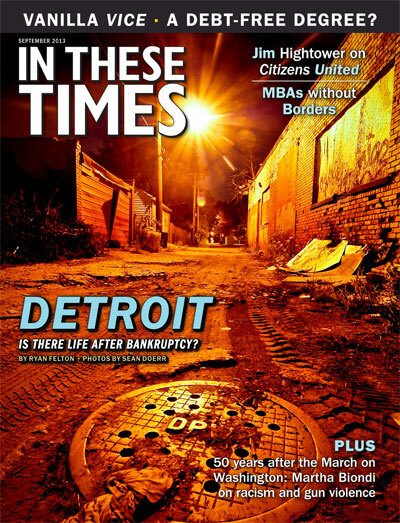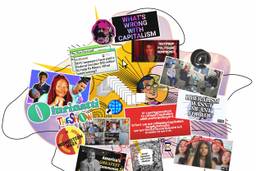Dystopia, for the ‘Lulz’
In MaddAddam, Margaret Atwood explores fundamental questions and mutant pigs.
Jude Ellison Sady Doyle

Of all the Great Living North American Writers, Margaret Atwood may be having the most fun. Having firmly established her cred as a serious writer with works like The Edible Woman and The Handmaid’s Tale, she’s now earned the right to a certain level of goofiness: Spending her days on Twitter, attending Comic-Con, and devoting the past 10 years to a post-apocalyptic saga filled with bad puns and mutant pig-beasts. It’s hard not to envy her: She’s done her work and assured her legacy — now gets to do what she likes.
MaddAddam, the third and final installment of that sci-fi saga, is probably the closest Margaret Atwood will come to writing a William Gibson novel. Underground hacker networks are established, narrow escapes are made and busty bordello proprietors are revealed to have hearts of gold beneath their scale-and-feather-embellished full-body prophylactics. Much of this action is narrated by a heroic hacker, the sort of man who — unironically, and in a moment of tenderness with his lover — uses the phrase “for the lulz.”
If all this sounds a little pulpy, well, it is. But it’s also the work of a great writer. The arguments that Atwood has built her career around — power, and how it is obtained; sex, and what it has to do with power; language, and how it serves or deceives us; survival, and how to do it in a natural world that is largely indifferent to our concerns — are all worked out in the MaddAddam trilogy. It just so happens that they are frequently expressed via mutant pig.
Oryx and Crake, the 2003 novel that kicks off the trilogy, remains the bleakest of the series. It centers on Jimmy, a mediocre copywriter and lifelong cad who believes himself to be the last surviving member of the human race. Filthy, malnourished and beginning to hear voices, he stumbles through the wilderness, gleaning food from the eerily placid, semi-human “Crakers” and reminiscing about the world he’s lost: one in which biotechnology was the only game in town and corporations had replaced governments and exploited the natural world to the point of collapse.
All of this culminated in a plague that a bioengineer named Crake unleashed upon humanity so that his creations, the Crakers, might inherit the earth. The book ended with Jimmy stumbling upon a miraculous group of human survivors and contemplating whether he ought to kill them. The story’s power came from the fact that, by the time those survivors arrived, we were none too happy to see them either. Although Oryx and Crake could be funny and tender in its depiction of human weakness, it was also so pessimistic it hurt.
Her 2009 follow-up, The Year of the Flood, backtracked a bit: She invented new survivors, more resilient than poor Jimmy, and gave them a past life as a cult of ecologically minded urban gardeners whose ethos might allow humanity a chance at life in the wake of the plague, or at least a less instantaneous death.
MaddAddam sticks, for the most part, to these survivors, both the peaceful Gardeners and their militant splinter group, the MaddAddamites. (Jimmy appears, but just barely. He’s one of her best-drawn characters — manipulative, self-absorbed, casually sexist and terminally average, but imbued nonetheless with an aching sensitivity, he’s an excellent argument for both human frailty and human worth — but he spends much of the book unconscious.) These survivors seem to do everything Jimmy can’t: Obtain their own food, build shelters, have conversations, create literature, fall in love. The utter despair of Oryx and Crake is a dim memory; the question of MaddAddam is not whether humanity should survive, but how.
As one of these love affairs unfolds — between the steely, pragmatic Gardener Toby and the lulz-prone MaddAddamite Zeb — the story dips, at length, into Zeb’s past. The Zeb sections are, unfortunately, the book’s thinnest and pulpiest. Where the other narrators in the MaddAddam trilogy have been recognizably human, Zeb is more or less an archetype: a tough, foul-mouthed, hairy-chested Alpha Dude. (Even his tragic childhood is a little cartoonish: Where Jimmy of Oryx and Crake had a depressive mother who abandoned him and Ren of The Year of the Flood had a frivolous mother more preoccupied with romantic entanglements than parenting, Zeb’s father just makes him eat feces.) His flashbacks are a fun read — I mean, the guy rips apart a mutant bear and eats it — but Zeb himself never seems as rich or as complicated as Atwood’s characters at their finest.
Instead, the book’s weight comes from the scenes set after the apocalypse. Whether or not the reader loves Zeb, Toby does, and the two of them manage to have the series’ only functional adult relationship. Atwood has always been clear that the pre-apocalyptic dystopia of the MaddAddam trilogy is a spiritual wasteland. Sex has been commodified, human life has minimal value, and anything that might add to the citizens’ emotional vocabulary — art, philosophy, spirituality — has been either twisted into the service of corporate profit or cast aside. All of the parents in this trilogy are bad parents: disengaged, absent or violent. All of the romances are bad romances: People use each other, pay each other or pine for each other, but rarely connect. As Atwood switches gears from dystopia to utopia, she names the human qualities and experiences that she believes will last. One of those experiences is the age-old ritual of two people, in a state of undress, reciting personal histories to each other in the hours before dawn.
We will always find a way to make intimates out of strangers. But we will also probably always find ourselves negotiating with strangers, including those we see as Other. And these are negotiations that, historically, we do not handle well. Much of The Year of The Flood has to do with the uneasy coexistence between the humans and the Crakers. The Crakers’ genetic engineering has supposedly eliminated symbolic thinking, aggression, recreational sex, property and hierarchy; however, this engineering was also intended to deprive them of art, love and metaphysics. The question of what humans can teach them — and whether we will inevitably corrupt them — remains open throughout the book. By the time the tale ends, the Crakers seem to understand what it means for two people to love each other, and they’re quite enthusiastic about this whole “art” concept. But they also seem to understand war and the necessity of “clearing away” those designated as “hurtful,” and at least one of them is apparently learning how to lie.
But then, at a certain point, lies are preferable. Without giving too much away, I will say this: MaddAddam becomes even more elegiac than Oryx and Crake. Atwood has been writing a story about the end of humanity for the past 10 years. But as the story itself winds to a close, we’re left with the fact that humanity — in large and small ways — is always ending. Everything and everyone will, in fact, go away. It’s just that we tend to go slowly and quietly, one at a time.
Jude Ellison Sady Doyle is an In These Times contributing writer. They are the author of Trainwreck: The Women We Love to Hate, Mock, and Fear… and Why (Melville House, 2016) and was the founder of the blog Tiger Beatdown. You can follow them on Twitter at @sadydoyle.









